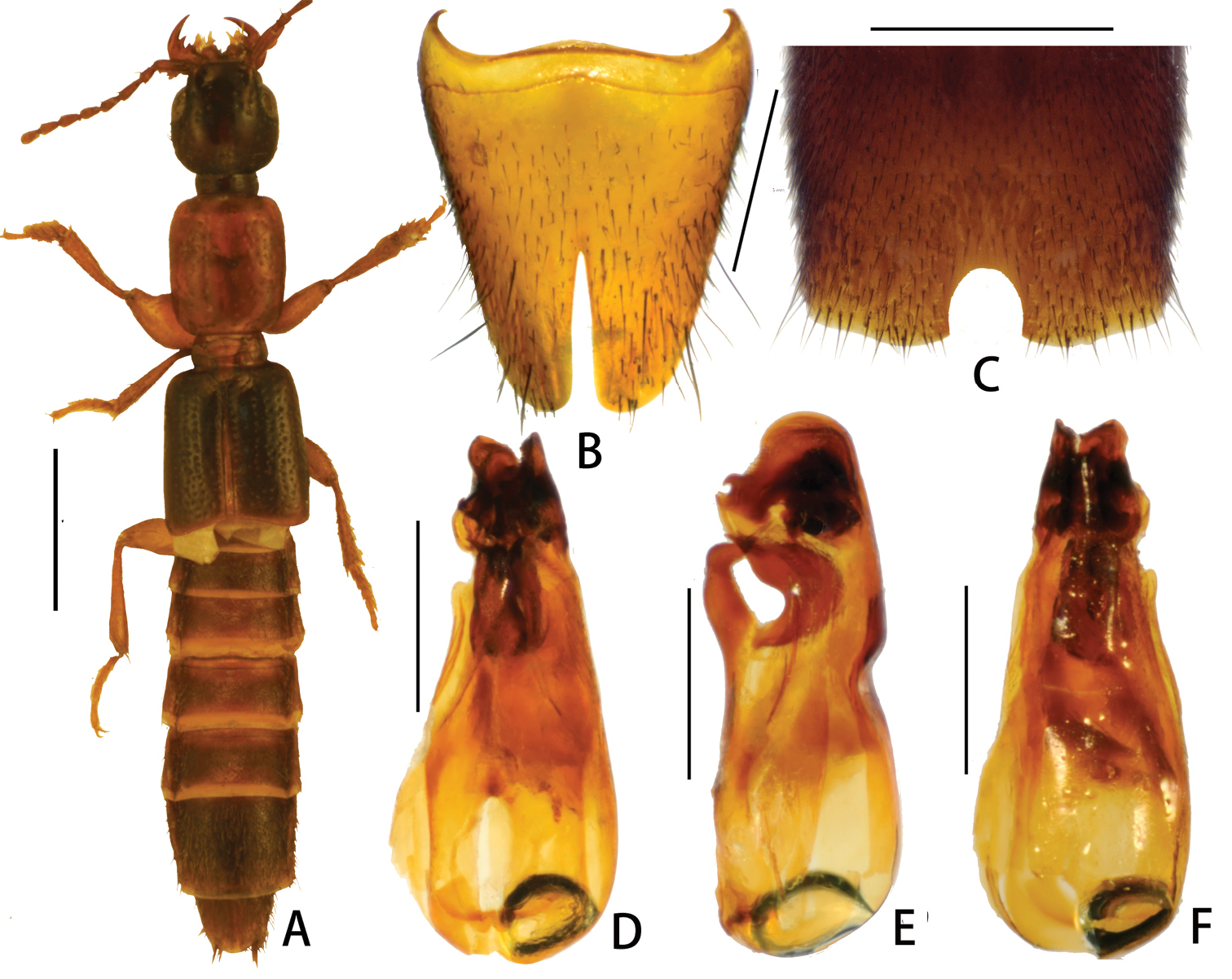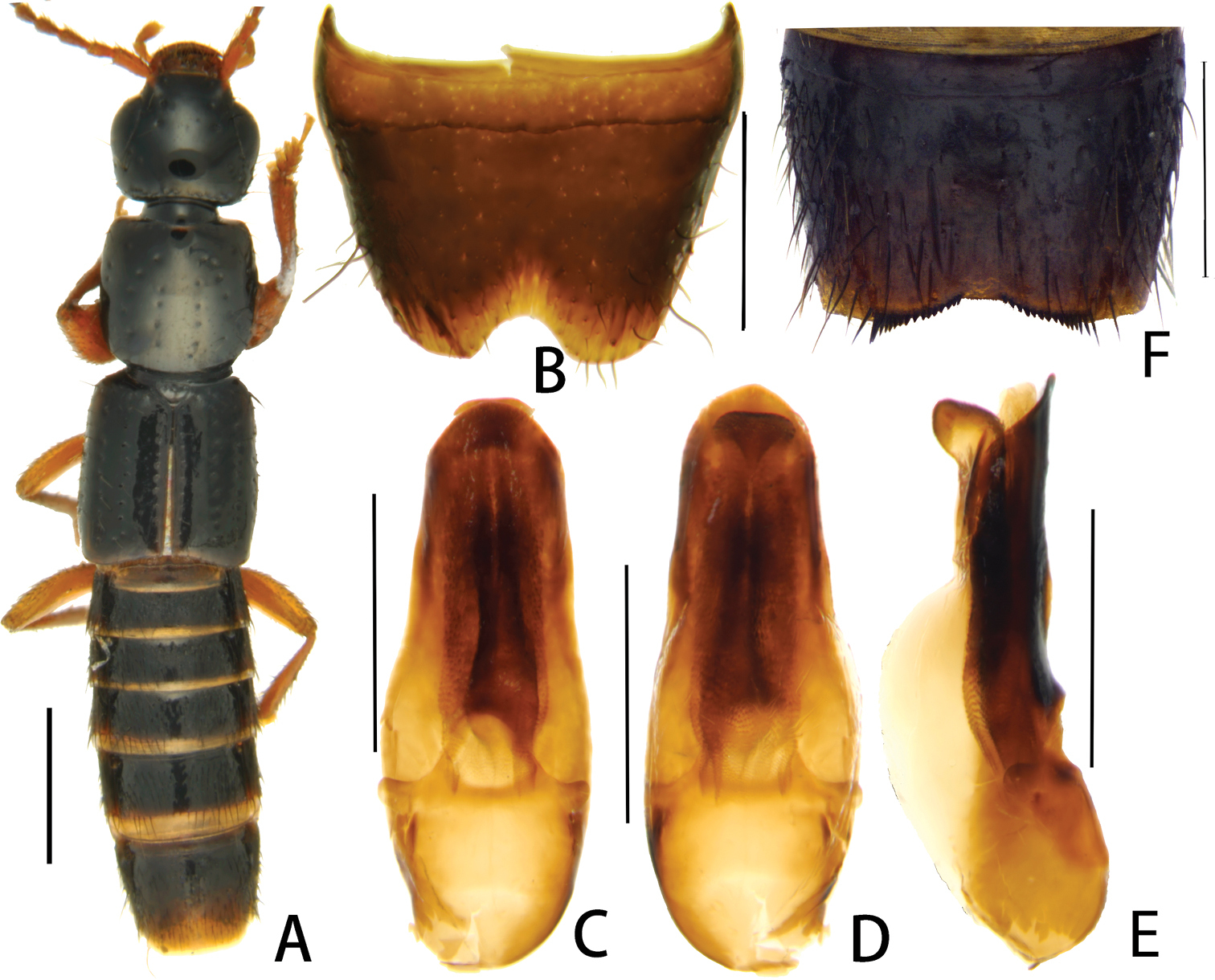






(C) 2013 Xiao-Yan Li. This is an open access article distributed under the terms of the Creative Commons Attribution License 3.0 (CC-BY), which permits unrestricted use, distribution, and reproduction in any medium, provided the original author and source are credited.
For reference, use of the paginated PDF or printed version of this article is recommended.
Citation: Li X-Y, Solodovnikov A, Zhou H-Z (2013) The genus Pseudolathra Casey in China: new species and new records (Coleoptera, Staphylinidae, Paederinae). ZooKeys 356: 1–9. doi: 10.3897/zookeys.356.5979
Two new species of the genus Pseudolathra Casey from mainland China are described and attributed to their respective species groups, P. cylindrata sp. n. from Hubei and Sichuan, and P. superficiaria sp. n. from Yunnan. Pseudolathra pulchella (Kraatz, 1859), P. transversiceps Assing, 2013 and P. bipectinata Assing, 2013 from Yunnan are reported from China for the first time. The history of the exploration of the Chinese fauna of Pseudolathra is summarized.
New species, Pseudolathra, Paederinae, Staphylinidae, China
Except for the better known West Palearctic region (ten species), the taxonomy, diversity, and zoogeography of the paederine rove beetle genus Pseudolathra Casey, 1905 are currently somewhat unclear (
With respect to China, a country of vast dimensions, rich biodiversity, and with a poorly studied rove beetle fauna, the discovery of numerous new species of Pseudolathra has been predicted (
Based on recently collected material, two new species from mainland China are here described and illustrated: Pseudolathra cylindrata sp. n. from Hubei and Sichuan, and Pseudolathra superficiaria sp. n. from Yunnan. Three additional species, Pseudolathra bipectinata Assing, 2013 (Yunnan), Pseudolathra transversiceps Assing, 2013 (Hainan) and Pseudolathra pulchella (Kraatz, 1859) (Hainan) are reported from China for the first time. Using the diagnostic characters provided by
The type specimens are deposited in the Institute of Zoology, Chinese Academy of Sciences (IZCAS) and some duplicate paratypes deposited in the collection of the Natural History Museum of Denmark (Zoological Museum of the University of Copenhagen, ZMUC).
Specimens were relaxed in warm water (60°C) for 10–12 hours for dissection of the last abdominal segments containing the aedeagus. The detached abdominal segments were placed into KOH (10%) for 10–24 hours (depending on the degree of sclerotization) to clean sternites VIII-IX and the aedeagus from the surrounding tissues. Then they were placed into 75 % alcohol for ca. 2 minutes and transferred to vials with glycerin for examination. After examination, the dissected parts were placed in plastic genitalia vials, which were pinned under the respective specimens. Observations, drawings and measurements were made under a compound microscope (Leica MZ–APO).
All measurements were taken with an eyepiece micrometer and are given in millimeters. Total body length was measured from anterior margin of labrum to apex of abdomen. Forebody length was measured from anterior margin of labrum to apex of elytra. All other measurements were taken and abbreviated as follows:
HL head length (from the anterior clypeal margin to the occipital constriction)
EyL eye length (in dorsal view)
AL antennal length (from the base of antennomere 1 to the apex of antennomere 11)
PL pronotum length (along midline)
EL from the apex of scutellum to the elytral posterior margin
PW pronotum width (maximal)
HW head width (including eyes)
EW maximal combined elytral width
ABW abdominal width (maximal)
http://zoobank.org/4E9E7410-468B-40BA-A130-32D979426B19
http://species-id.net/wiki/Pseudolathra_cylindrata
Figure 1Holotype, ♂, Hubei, Zigui, Jiulingtou 110 m, 5.IX.1994, collected by Fasheng Li (IZCAS); paratypes, 1♀, same data as holotype (ZMUC); 1♀, Sichuan, Fengdu 200 m, 1.VI.1994, collected by Youwei Zhang (IZCAS).
Length: 6.5–6.9 mm; length of forebody: 3.4–3.8 mm. Body glossy, vividly colored with head capsule black, pronotum and abdomen brown, elytra black with the apical margins more or less blackish-brown; antennae and mouthparts dark reddish, legs brownish red.
Head glossy, approximately as broad as long, vertex slightly convex. Punctures on head coarse and sparse, in median dorsal portion very sparse; interstices without microsculpture, but with micropunctation. Eyes relatively small and slightly protruding laterally. HL/EyL = 2.8, eyes shorter than postocular region in dorsal view. Antennae slender, about 1.9–2.0 mm long; all antennomeres oblong.
Pronotum oblong, PL/PW = 1.2, widest at its anterior third and approximately 1.2 times as broad as head, lateral margins straight; on either side of the impunctate midline with series of 13–16 punctures, some of these punctures often accompanied by additional punctures; punctures of lateral portions sparse to moderately dense; interstices without microsculpture.
Elytra parallel-sided, EL/EW = 8.5, slightly longer than pronotum; punctures on surface arranged in 5 series in dorsal view; interstices without microsculpture. Hind wings fully developed.
Abdomen approximately as broad as elytra, wider than head or pronotum; punctation very fine and dense; interstices with microsculpture; posterior margin of tergite VII with palisade fringe.
Aedeagus (Fig. 1D–F) about 1.25 mm long, length/width = 2.4. Dorsal plate fused with median lobe. Ventral process strongly sclerotized and curved (Fig. 1D, E). Internal sac with some strongly sclerotized structures.
Pseudolathra cylind rata sp. n. from Hubei and Sichuan. A habitus B sternite VIII, male C sternite VII, male D aedeagus, dorsal view E aedeagus, lateral view F aedeagus, ventral view. Scale bars: A = 1 mm; B–F = 0.5 mm.
Male sternite VII (Fig. 1C) with narrowly semicircular excision, margins of this excision slightly depressed; male sternite VIII (Fig. 1B) with posterior excision narrow and deep, not quite reaching middle of sternite.
Female sternites VII-VIII without any modifications.
The species name is the Latin adjective meaning cylindrical. It refers to the shape of the aedeagus of this new species.
Based on the relatively smaller body size, brownish coloration with darker head and elytra, as well as distinctly sclerotized aedeagus with an apically projecting dorsal plate, the new species belongs to the Pseudolathra unicolor group sensu
Pseudolathra cylindrata sp. n. is known only from the type locality: Jiulingtou in Zigui County, Hubei. The type series was collected in the period from June to September, the altitudes ranging from 100 to 200 m.
http://zoobank.org/32416B79-5297-4242-91CD-CE76BDCE00B2
http://species-id.net/wiki/Pseudolathra_superficiaria
Figure 2Holotype, ♂, Yunnan, Mengla County, Township Yaoqu, 1030 m (21.73°N, 101.52°E), 4.X.2010, leg. Xi Zhang (IZCAS).
Length: 6.5 mm; length of forebody: 3.2 mm. Body black, glossy; abdomen with posterior and lateral margins slightly dark reddish; legs, antennae and mouthparts reddish.
Head (Fig. 2A) weakly transverse, approximately 1.1 times as wide as long; vertex slightly convex, posterior angles marked. Median area almost impunctate, lateral portions with coarse and very sparse punctures; punctures around eyes and along neck relatively fine and dense; interstices without microsculpture and micropunctation. Eyes large and bulging, HL/EyL = 1.7, approximately 1.5 times as long as postocular region in dorsal view. Antennae slender, about 1.85 mm long; antennomeres III-X with very narrow bases and broadened apices.
Pseudolathra superficiaria sp. n. from Yunnan. A habitus B sternite VIII, male C aedeagus, ventral view D aedeagus, lateral view E aedeagus, dorsal view F sternite VII, male. Scale bars: A = 1 mm; B–F = 0.5 mm.
Pronotum (Fig. 2A) approximately as long as broad and as wide as head, anterior angles distinct and posterior angles round; on either side of the impunctate midline with series of 1+4 coarse punctures in dorsal view; lateral portions with very sparse and coarse punctures; some of those coarse punctures having additional smaller punctures.
Elytra with EL/EW = 8.7, slightly longer than pronotum, with fine epipleural ridge; punctures on dorsal surface arranged in 3 pronounced series on each elytron; interstices without microsculpture. Hind wings fully developed.
Abdomen approximately as broad as head or pronotum, but narrower than elytra; punctation on tergites III-V very coarse and dense, tergites VI-VIII with punctures relatively fine and dense; interstices without microsculpture; posterior margin of tergite VII with palisade fringe.
Aedeagus about 1.1 mm long, length/width = 2.7, weakly sclerotized, shaped as in Fig. 2C–E.
Malesternite VII (Fig. 2F) with posterior margin weakly and broadly concave, on either side of the middle with comb of stout, black, spine-like setae increasing in length and thickness laterad, margins of the concavity slightly depressed and glabrous; male sternite VIII (Fig. 2B) with semicircular, broad and relatively shallow posterior excision.
Females unknown.
The species name is the Latin adjective meaning superficial. It refers to the shallow posterior excision of the male sternite VIII of the new species.
Based the synapomorphic modifications of the male sternite VII (posterior margin bipectinate and notched in the middle) and the similar morphology of the aedeagus, the new species is closely allied to Pseudolathra bipectinata. For illustrations of Pseudolathra bipectinata see figures 17–18, 22–23 in
In fact, the shallow and broad excision of the male sternite VIII was previously reported as a uniquecharacter of the monotypical Pseudolathra regularis group (
The only known specimen of Pseudolathra superficiaria sp. n. was found in the leaf litter of the forest of rubber trees near the center of Yaoqu, a town in Mengla County, Yunnan. It was collected in October by sifting leaf litter at an altitude of 1030 m.
4♂♂, 3♀♀, Yunnan, County Jinghong, Nabanhe Nature Reserves 730 m, 16.IV. 2009, leg. Lingzeng Meng; 1♂, 3♀♀, same data but 770 m, 6.IV.2009; 2♂♂, 3♀♀, same data but 710 m; 2♂♂, 3♀♀, same data but 730 m, 6.VI.2009; 3♂♂, 2♀♀, same data but 760 m, 6.IV.2009; 1♂, 1♀, same data but 770 m; 2♂♂, 3♀♀, same data but 800 m, 16.IV.2009; 3♂♂, 3♀♀, same data but 1110 m, 16.V.2009 (IZCAS, ZMUC).
Pseudolathra bipectinata is illustrated and its distribution mapped in
1♀, 1♂, Sichuan, City Luzhou, 4.VI.1974, leg. Yinheng Han (IZCAS).
The previously known distribution of Pseudolathra lineata Herman included Japan, as well as Taiwan and the mainland Chinese province, Jiangsu (
Hainan, 3♂♂, 5♀♀, Qiongzhong City, Limu Shan 600 m, 15.V.2007, leg. Zongyi Zhao; 1♀, Lishui, Diaoluo Shan (light trap, 18.66N, 109.93E) 60 m, 24.III.2007, leg. Hongliang Shi and Feng Yuan; 3♂♂, 2♀♀, Guangdong, Cheba Shan, Nature Reserve Conservation Zone, 370 m, 22-26.VII.2008, leg. Zhuo Yang (IZCAS, ZMUC).
The morphology of Pseudolathra pulchella was redescribed by
3♀♀, 2♂♂, Beijing, Haidian, Yingtaogou, 19.V.1997, leg. Haisheng Zhou; 1♂, Changping, 20.X. 1988, leg. Huiying Wang; 1♀, Haidian, Qionglongqiao, 15.V.1997, leg. Haisheng Zhou; 1♀, Haidian, Jiufeng, 3.VII.1997, leg. Haisheng Zhou; 1♀, Haidian, Anheqiao, 13.VI.1996, leg. Haisheng Zhou (IZCAS, ZMUC).
Previously, this species was known from Japan, and from the southern and western parts of China (Jiangsu, Yunnan, Shaanxi, and Sichuan) (
♂, Hainan, Bawang Shan, 1000 m, 28.XI.2009, leg. Zongyi Zhao; ♂, Yunnan, City Jinghong, County Menghai, Nabanhe nature reserve conservation zone, 1110 m, 16.III.2009, leg. Lingzeng Meng (IZCAS, ZMUC).
Pseudolathra transversiceps was previously known only from Vietnam (
3♀♀, Yunnan, Xishuangbanna Yaoqu, 5.VIII.2006, leg. Gang Yao; 1♂, Xishuangbanna Xiaomengyang 850 m, 20.VIII.1958, leg. Yiran Zhang; 2♀♀, Luxi, 24.VI.1958; 2♀♀, Jiangxi, Dongxiang, 6.VII.1957, leg. Xuewen Ying; 1♀, Huichang, 20.VI.1959; 1♀, Fujian, Shaowu, 1980, leg. Zhanghong Qiu; 1♀, Guangxi, Guilin, Yan Shan, 12.V.1963, leg. Chunguang Wang; 1♀, Guangdong, Boluo Xiangshui, 30.V.1965, leg. Youwei Zhang; 6♀♀, 2♂♂, Tonkin, Hoa–Binh, 1940, leg. A. de Cooman (IZCAS, ZMUC).
Pseudolathra unicolor is a widespread species, its distribution ranging from the Himalaya deep into the Oriental region (
We are especially grateful to the colleagues who collected and sent us examined material. We would also like to express our sincere gratitude to Harald Schillhammer (Vienna), one anonymous reviewer, as well as Volker Assing (Hannover), the subject editor, for their help in improving our manuscript. The paper is part of the study of Chinese Paederinae conducted under the financial support of the National Natural Science Foundation of China (31101656, 31272358, J1210002), CAS Innovation Program (KSCX2-EW-Z-5), and the grant from the Key Laboratory of the Zoological Systematics and Evolution of CAS (No. O529YX5105).

